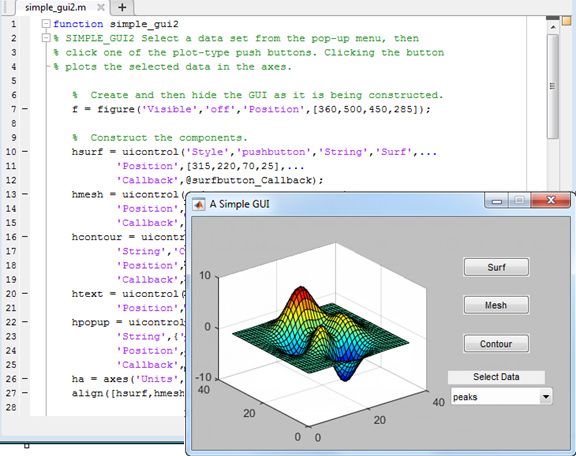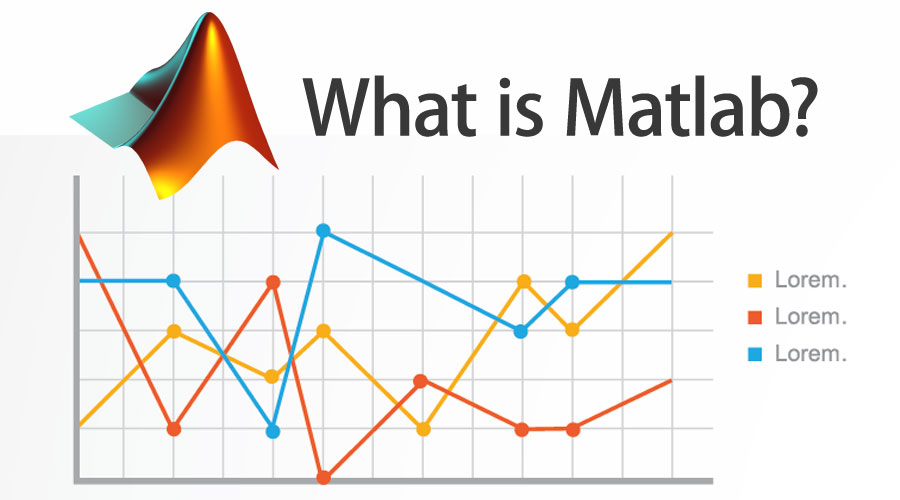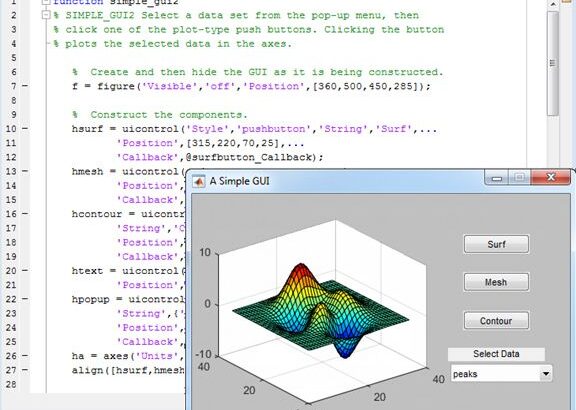MATLAB Crack + Product Key

MATLAB Crack is a programming and numerical computing platform used by millions of engineers and scientists to analyze data, develop algorithms, and create models. MATLAB® combines a desktop environment suitable for iterative analysis and design processes with a programming language that directly expresses matrix and matrix mathematics. It includes the live editor for creating scripts that combine code, output, and formatted text into an executable notebook. toolkits are professionally developed, thoroughly tested, and fully documented.
With interactive applications MATLAB apps let you see how different algorithms work with your data. Iterate until you get the results you want, then automatically generate a program to replicate or automate your work. Scale your analytics to run on clusters, GPUs, and clouds with only minor code changes. There is no need to rewrite your code or learn big-data programming and low-memory techniques. code is production-ready, so you can directly access your cloud and enterprise systems, integrating data sources and business systems.
MATLAB License Key works with Simulink to support model-based design used for multi-domain simulation, automated code generation, and testing and verification of embedded systems. Capture, process, and analyze images and video for algorithm development and system design. Transform your robotic ideas and concepts into autonomous systems that work seamlessly in real environments. At MathWorks, we believe in the importance of engineers and scientists. They expand human knowledge and fundamentally improve our standard of living.
We built Simulink to help them do their best.
You may also like this Borderlands 3 Crack
MATLAB Crack Features
- MATLAB® is the easiest and most productive computing environment for engineers and scientists.
- With math, graphics, and programming, it’s tailored to the way you think and the way you work.
- Simulink® is a block diagram environment for the simulation and model-based design of multi-domain and embedded engineering systems.
- Explore, test, and implement MATLAB Serial Number designs you wouldn’t otherwise consider, in a fraction of the time it would take to write C, C++, or HDL code.
- Each MathWorker brings a unique experience and perspective, but we share a set of core values.
- These values help create a dynamic, streamlined workplace that fuels our growth as individuals and as a company.
- Our goal is to change the world by accelerating the pace of discovery, and innovation.
- Development, and learning in technology and science.
- Our guiding principle is ‘doing what’s right’, which means doing what is best for our employees.
- Customers, business partners, and communities over the long term believe that there are ‘right’ answers.
- We believe in continuous improvement and the pursuit of excellence, and respect.
- And investment in each other, a lean workplace, learning and self-improvement, credibility, and integrity.
- We actively support our local and professional communities through initiatives that advance STEM education and encourage employees to volunteer.
- Build environmental sustainability and support global relief efforts.
More Features
- MathWorks was founded in 1984 by Jack Little and Cleve
- Moler recognized the need for engineers and scientists for more powerful and productive computing environments beyond those of languages like Fortran and C.
- They combined their mathematical expertise, engineering, and computer science to develop MATLAB Keygen.
- Tackle research and development by scientists and engineers.
- Some of the biggest challenges in the world MathWorks is committed to acting responsibly as a global corporate citizen.
- Our core values and belief in “doing the right thing” guide us in leveraging our unique business strengths to achieve meaningful results.
- We believe that investing in our social mission program will help us be leaders in our communities and in the field of technical computing.
- We support innovative programs that advance education in the disciplines of engineering, science, and math.
- Employee-centric initiatives We empower our people to use their time and talent in ways that transform lives.
- Local community support We support the vitality of the communities.
- which we operate by contributing to organizations that contribute to the development and enrichment of our cities and communities and by participating in local initiatives.
MATLAB Crack System Requirements
- Green initiatives We support environmental sustainability through programs focused on recycling.
- improving energy efficiency, resource management, and facility design.
- Disaster relief Worldwide relief efforts In times of crisis, we provide financial assistance through approved aid organizations.
- Luc Masson, president of the INJENO association, once dreamed in the north of France that his nine-year-old daughter could walk.
- Inès suffers from several neurological disorders that affect her motor skills, including epilepsy.
- She uses a wheelchair with a headrest and needs help navigating the world around her.
- In 2010, Masson joined the Robotics and Mechatronics group of Laurent Peyrodie at the JUNIA HEI School.
- Science and Engineering of the Catholic University of Lille.
- He envisioned an autonomous lower limb exoskeleton that pediatricians could use as a MATLAB Serial Key a physiotherapy tool.
- The device would also give children like her daughter the chance to experience the world in a new way.
- “Luc is very enthusiastic and personable,” recalls Peyrodie, who also heads the biomedical signal processing department in Lille.
- “He asked, ‘Can you do something for us? “With this question in mind, we began various studies with university students.”
- Peyronie recruited postdoctoral researcher Yang Zhang to lead the mechanical and electronics development.
- The JUNIA HEI Motion project brings together technicians and mechanical and biomedical engineers.
- And healthcare professionals to make mechanized orthotics a reality for children with severe neurological conditions.

What’s New MATLAB Crack
- More than a dozen commercial, nonprofit and academic partners have joined the effort.
- And the project has secured 7.4 million euros ($7.2 million) in research funding from a European program.
- Peyronie and Zhang created prototypes using 3D-printed parts, low-vibration DC motors, and embedded sensors.
- They accelerated development by using MATLAB®, Simulink®, and Simscape.
- Multibody™ to model motor dynamics and design motor controls.
- The team turned to MathWorks partner Speedgoat for efficient real-time testing on prototype hardware.
- Recently, a small colleague who participated in the project entered the latest prototype.
- In the coming months, the team plans to seek permission to test the exoskeleton with children.
- The Motion Project cited a MATLAB Product Key Swedish study that found that 30% of children in the country with cerebral palsy (CP) could no longer walk by the age of five.
- Another 16% used walking aids.
- Based on these statistics, the project team estimated that exoskeleton technology could benefit 6,500 children under 10 in Europe.
- And that’s only for those who have CP.
- There are many other medical conditions that affect leg movement.
- “We had to find a way to build the prototype in a short time with just a few people.
- “Laurent Peyrodie, JUNIA HEIDespite these health care needs, exoskeletons are still considered adult equipment.
- Such as those worn by the fictional Iron Man or the real ones designed to prevent injury.
- In the United States, the US military has developed.
How to Install it?
- The Human Universal Load Carrier (HULC) lifts up to 91 kilograms (200 pounds) and plans to deploy a new flexible and lightweight exoskeleton next year.
- Making an exoskeleton approved for medical use by children with multiple disabilities.
- Many of whom have communication difficulties require a thorough clinical evaluation of their safety.
- “Testing the structure on children in a clinical setting is extremely difficult because.
- We have to demonstrate that there is no risk or harm to them,” Peyrodie said.
- Obtaining ethics approval from a committee is a critical step, he continued.
- According to this document, the European Medicines Agency must go through a long MATLAB Activation Key evaluation process that manufacturers of medical devices must follow before they can affix a European conformity mark (CE) on a product.
- Another challenge in the development of pediatric lower extremity exoskeletons has been price.
- The idea was that rapidly growing children need different systems, which multiplies the cost.
- That’s why the Motion Project’s unique system is designed to accommodate changes in size and weight.
- The JUNIA HEI Motion project targets children aged eight to twelve who have a wider range of disabilities.
- Including lower limb paraplegia. The structure must be adjustable for carriers of different heights and weights up to 50 kilograms (110 pounds).
Conclusion
“It’s a pretty complicated project,” Peyrodie said. “It’s like a start-up: you had to find a way to build the prototype in a short time with few people.” Interreg 2 Seas, a European Territorial Cooperation program covering the area bordered by the Channel and connected to the North Sea, MATLAB Crack invested in numerous sustainable and inclusive cross-border cooperation projects from 2014 to 2020. The program approved funding for the Motion project in 2019. Although the original timeline for the project was slightly extended during the pandemic, the team still needed to move quickly with prototyping.
Bionics reinventing the movement of walking requires the construction of a sophisticated robotic system robust enough for young people and their caregivers to have complete confidence in its autonomous functionality. The medical device must also be simple enough to be used safely by a therapist. Initially, the researchers attempted to design their exoskeleton in C++, but the hand-coding process dragged on. “It was impossible in the time we had for the project,” recalls Peyrodie. “A project partner at KU Leuven in Belgium used MATLAB and Simulink in combination with Speedgoat® as a time-saving solution.”
